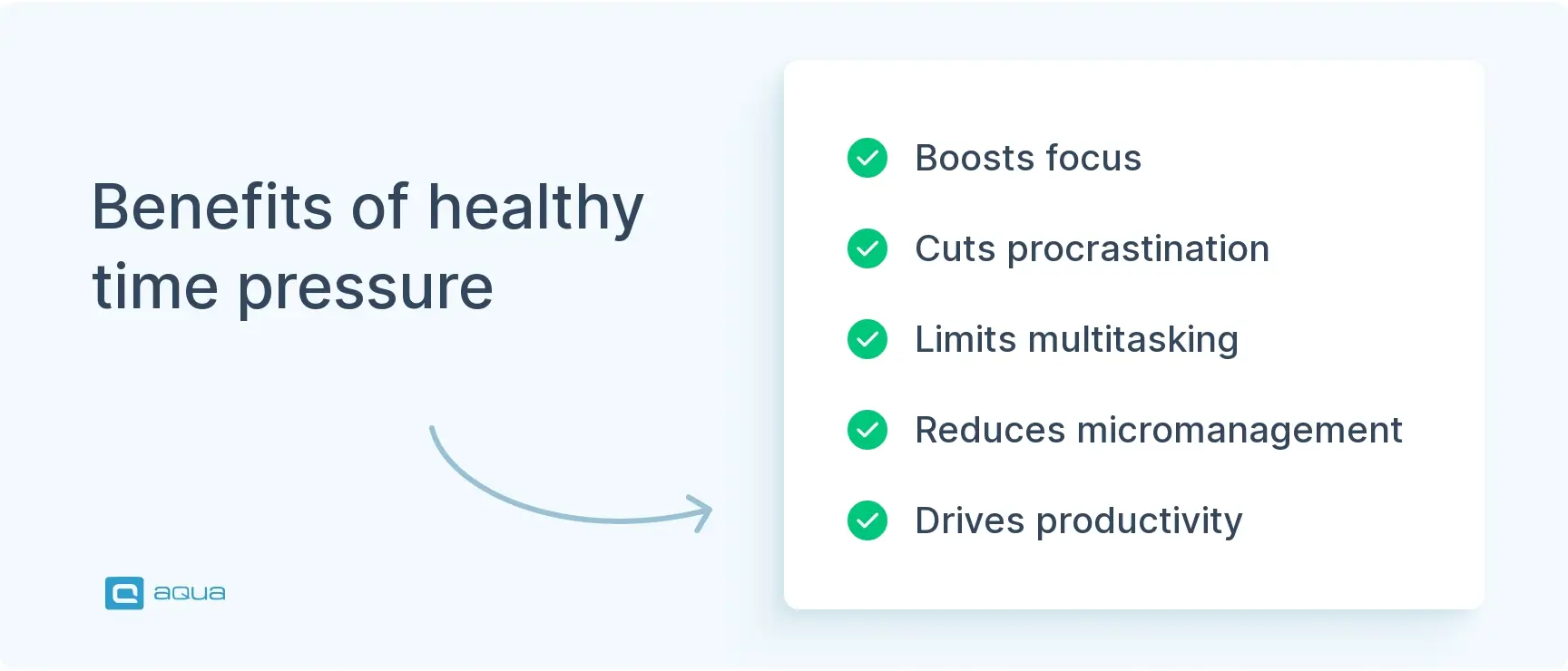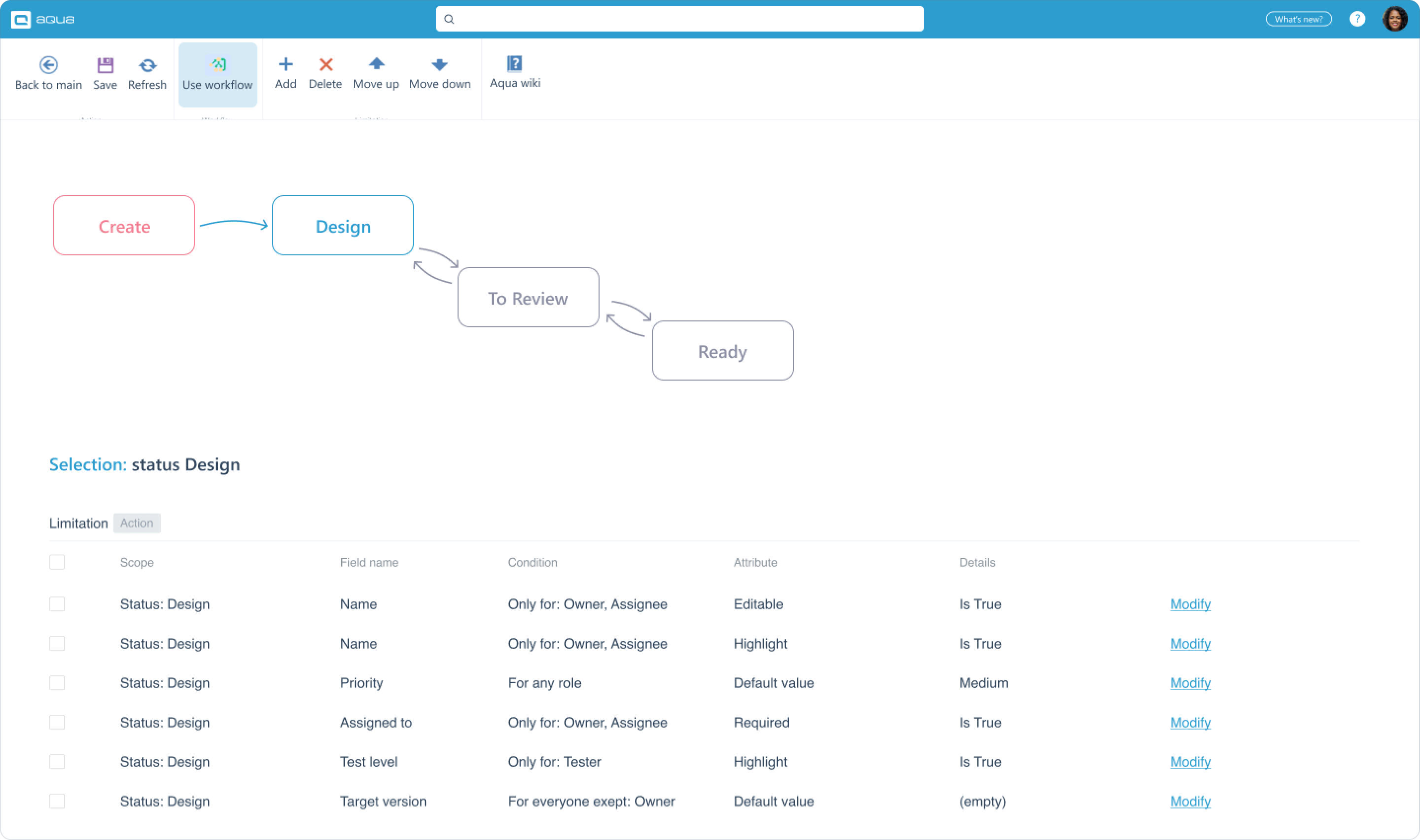All QA leads are struggling to find this golden ratio — it should be enough to have an adequate deadline without time pressure in QA in general but not too long to cause procrastination.
When it comes to time management, many people need to realise that there are several different types of time pressure. Some of them help increase productivity — like clear deadlines, flexible working hours, while others hinder a tester’s performance — strict deadlines without situationality or overworking. But anyway, time pressure in software testing can be used as a tool for your journey on how to increase productivity in the software industry.
What causes time pressure in QA testing?
Being under pressure in any job is a frustrating experience. It often creates a sense of urgency that may increase stress, potentially affecting decision-making and overall performance. The added strain might also impact the quality of your work, causing further frustration because you can’t deliver at the expected level.
So, why does the pressure on QA testing suddenly ramp up? Here’s the lowdown on what creates this sudden rush:
- Shifting Deadlines: Changes in project timelines or sudden deadlines can significantly compress testing schedules, causing time pressure and panic.
- Unexpected Bugs: Unforeseen glitches or bugs during testing demand immediate attention, disrupting your planned timelines and adding pressure.
- Scope Creep: When project requirements expand beyond the initial plan, more testing tasks are crammed into the same timeframe, intensifying time constraints.
- Resource Constraints: Shortages in team members or insufficient testing tools can amplify time pressure in testing, as tasks might take longer due to limited resources.
For better time pressure management in testing, you should address these factors proactively to ensure smoother and more effective time utilisation.

Risk-Based Testing: Maximise Impact Under Time Constraints
When deadlines tighten or resources get squeezed, you can’t test everything with the same intensity. Risk-Based Testing (RBT) gives you a smart way to zero in on what matters most. Here’s how it works: rank your features and modules based on business impact and failure likelihood, then point your testing firepower at the highest-risk areas. Start by creating a simple matrix – list features down one side, rate business impact (1-5) and failure probability (1-5) across the top, then multiply the scores.
Anything scoring 15+ gets your full attention. This approach means having honest conversations with stakeholders about testing coverage – being upfront about what gets thorough testing versus basic smoke tests. Companies using RBT typically catch nearly 30% more critical bugs while using the same testing time.
One benefit is that the time pressure actually becomes your friend, forcing clearer decisions about what truly needs protection. Your most important product areas stay bulletproof, even when the clock’s working against you.
It helps abstract from procrastination
Let’s start with not the most obvious point – procrastination. There are thousands of coaches who are ready to teach your team to erase procrastination. But can they really do this? I think not.
On a personal level, procrastination can be caused by depression or undiagnosed ADHD (I think we don’t speak enough about mental health and its correlation for successful team management). On a corporate level – a lack of proper time management.
When your QA team’s drowning in work, you need a reality check on deadlines, not just shorter ones, but smarter ones. You need to start tracking how long testing actually takes versus estimates. Most teams discover their initial time predictions were off by nearly 40%.
One tester being constantly behind while others manage fine? That’s rarely about skill gaps. Personal stuff, burnout, or even undiagnosed health issues often hide beneath missed deadlines. A quick coffee chat can reveal more than any performance review.
Your first move should be mapping out the current testing loads across the team this week. You’ll spot the bottlenecks fast – and probably find some surprising solutions. By any kind of time pressure I mean two of them — negative and positive.
Negative time pressure can be represented by unrealistic deadlines, overloaded workflow, an enormous number of urgent tests and a stressful schedule of work. I understand that it is an absolutely unhealthy environment to work, but unfortunately, sometimes it happens even in the coolest companies.
Positive time pressure is represented by adequate deadlines, a flexible schedule of tasks, and the realistic expected time for finishing tests.
Here is an example of how you can utilise positive time pressure in your team with aqua.

It’s an aqua workflow. You set all necessary steps up with the expected results. It works almost like a coding algorithm —“if yes, then do this”.
And if you see that some of the steps don’t work like it is supposed to, you just adjust it and adjust your expectations about results.
And right after, you go to notifications and send all your team an email “Hey guys, no rush (or rush). I fixed our workflow, stakeholders can see changes too, we are fine.”
Such a workflow helps you see small steps instead of a scoop of tremendous workload. It’s easier to do small tasks, which decreases procrastination in your team.
Remove aggravation from your project management
Decrease unhealthy multitasking
I am still waiting for the moment when society finally realises that multitasking is not the norm. And they confirmed it 13 years ago in the Stanford study.
In most cases, it’s just one of the procrastination forms — just switching between tasks making an illusion of work but in reality, avoiding other tasks. Does it sound familiar?
So in this situation, time pressure can be good reins for a tasks-juggler.
You receive an assignment from your manager and have to complete it within a certain timeframe. This kind of pressure can be helpful if you’re given enough time to finish your tasks, but if you’re given less time, it will prevent you from doing quality work on your projects… or switching to other tasks when it’s unnecessary.
You have a certain deadline and a certain amount of hours for these tasks, so please be nice to meet them — here is exactly what our content lead, Tania does in aqua, and it works pretty well.
Get rid of micromanagement
If you have ever seen ”Simpsons” you probably remember the episode where Homer and his family are going on a trip, and kids keep asking, “Are we there yet” during the entire trip. A typical micromanagement case.

If you are a QA lead or senior developer, it’s quite challenging to admit that you micromanage your team. But if you do, you better stop. And time pressure can help with better time management in testing without micromanagement.
Start setting up time frames for tasks for yourself first but not for the team. Let’s say you know that this task takes 20 hours to be done, and adequately the first scoop of tests will be done only in 4 hours.
So, don’t go and check statuses an hour after they receive an assignment. Give you a spare hour on the top of these four hours — so, if they are not done with test results yet, then you can go and check in another hour just to make sure there is some progress.
Modern Tools and Automation: Easing the Time Crunch
You should combine automated testing frameworks with cloud-based grids and AI-powered tools to squeeze more testing into tighter windows. Tools like Selenium, Cypress, and Playwright, paired with services like aqua cloud, let your team automate those mind-numbing regression tests – then run them across dozens of environments at once. What used to take days now wraps up in hours.
AI tools can actually fix broken test scripts on their own now and throw in suggestions for new test cases, which nearly cuts maintenance time in half. Here’s your starting point: pick one repetitive test suite that burns through your team’s time each sprint and automate it first. When you combine smart automation with strategic test prioritisation, you’ll keep quality high even when deadlines get aggressive, and your team won’t burn out chasing impossible timelines.
Conclusion
Productivity of your QA and software development team is the final outcome of many aspects, such as efficient workflow, applied methodologies, and rational time management. And it also includes adequate utilising of time pressure.
You’ll know you’ve nailed QA time pressure when your team isn’t panicking but also isn’t dragging their feet. Most teams either slam the gas pedal (hello, critical bugs in production) or cruise too slowly and miss deadlines entirely.
Your bug escape rate drops while your release confidence goes up. It’s totally doable.
In order to build a successful QA team you will certainly need to explore how to use time pressure for better. And it also might make you face some ugly sides of management — mental health problems, unpleasant management habits, and old stereotypes. But as you master it, be ready, it can bring the sweetest fruits of your work.
Squeeze better results with robust testing tool


















